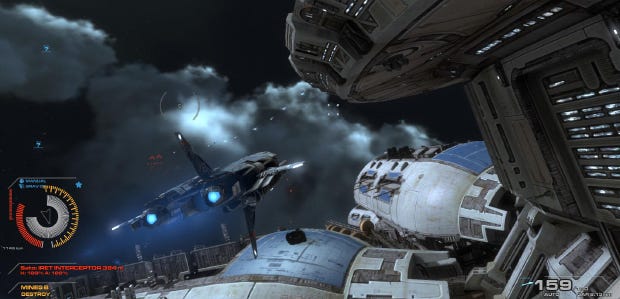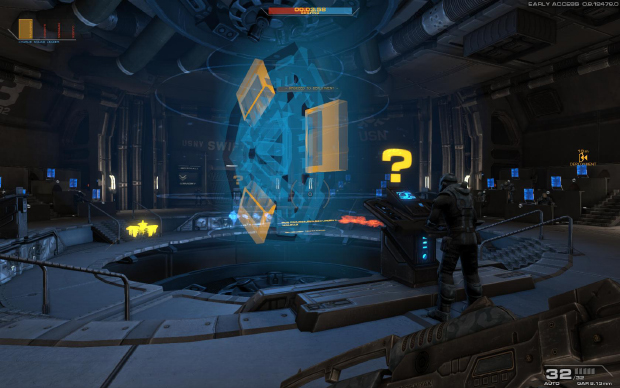Premature Evaluation: Angels Fall First
Celestial Bodycount
Each week Marsh Davies screeches out the airlock as part of a frontline assault upon the forces of Early Access and comes back with any stories he can find and/or makes no appreciable difference to the war effort whatsoever. This week he’s fodder for the 64-man battles of Angels Fall First, a promising indie alternative to the likes of Battlefront, with space combat to boot.
Going toe-to-toe with a triple-A title often spells disaster for a superficially similar indie, but perhaps there’s some wisdom in releasing Angels Fall First at the same time as the beta for Star Wars Battlefront. For one thing, this asymmetric, objective-based, large-scale, sci-fi, team-shooter isn’t locked behind Origin, EA’s proprietary wedge of electronic consumer-molestation, which not even the seductive power of The Force can compel me to reinstall, so coddled am I in cosy, Steam-induced inertia. For another, it’s only 15 quid, and quite possibly a more ambitious and interesting game, with dense and detailed missions broken into multiple stages of operation across different arenas of combat, conjuring spectacular chaos for infantryman, driver, airpilot and spacecadet alike - all orchestrated by elected commanders with an eye on the ebb and flow of the overall battle.
With human intelligence directing that mass action, your individual dogfight ascends in significance: your ship may well have exploded mere seconds after hitting the vacuum, but it’s consoling to know that it did so as part of the larger drama experienced by a vanguard of fighters and bombers, dropping out of hyperspace to pick off the defences of a spacestation. Doing so without too heavy a loss of life allows your capital ship to warp in, unleashing player-piloted boarding vessels to breach the enemy’s hull and unload a cargo of angry gunmen to seek and destroy vital systems. Then, hopefully, they can thieve an enemy fighter plane from the cargobay before the entire thing explodes. Each one of these roles is yours to play or oppose, your lives and deaths part of a larger plan that might otherwise be obscured by the cordite smog and blinding laser fire of battle.
Or, indeed, obscured by the distracting wonkiness of this Early Access release. As ambitious as it is, Angels Fall First visibly strains at the seams of its budget. It’s unpolished and buggy in any number of ways: the UI is a barely navigable cacophony of text overlays and 3D representations arranged with no apparent sense of hierarchy; the malfunctioning tutorial is prone to slip important bits of information past you in rapid bursts of miniscule text that are then never repeated; and occasional glitches prevent the use of weapons, deny vital interactions, and, seemingly, sometimes impede being able to receive those all-important commands.
Most critically, it’s not yet entirely playable online. The devs’ own mea culpa shortly after launch suggests there might be teething problems with the netcode, but I’ve only had one crash. Instead, the problem is that there just aren’t enough people playing to adequately populate more than a single server. Over the last few days, I’ve only spotted one game available at any time with a substantial human headcount and it’s always been password protected. Though I’ve kicked around in the game with a friend and the odd random player, it’s impossible to get an appreciation for it as much more than a proof of concept: you can fill the server full of bots, and it creates a more than adequate sense of scale and spectacle, but absent are the strategic depths permitted by human commanders. As the sole human player - and a new one - grappling with an impenetrable and buggy command UI proved beyond me, while the AI commander seemed no more competent, ordering our troops to defend unthreatened outposts, while leaving critical objectives vulnerable.
In the game’s primary game mode, attackers must push through three phases of assault, unlocking each with the successful completion of critical objectives. While defenders must ultimately protect these until the mission timer runs out, canny commanders might choose to divert resources to target the attackers’ spawn points to deny reinforcements and force a retreat. If such strategic decisions are currently out of reach, then there’s perhaps too much tactical choice available to the average grunt: loadouts for both individuals and vehicles offer a huge number of guns to choose from, nearly all of which are semi-automatic ballistic weapons, the finer qualities of which are hard to know or compare. There’s a similar bounty of kit items and grenades too, but you are limited in what you can carry by three factors: your offensive capability, your team-support capability and your command capability. Different items fulfil these roles variously, and your soldier has a max number of points that any category will accept. It’s a clever but slightly fussy way of preventing players from overpowering themselves in any one area, and requires a lot of experimental inventory-juggling to mix-and-match a workable loadout.
As for the moment-to-moment pleasures of using this arsenal, Angels Fall First hasn’t quite matched the tactile gun-blam-itude of other top-tier shooters. Confusingly, looking down the iron-sights doesn’t always line them up with the point at which you’re firing, thus making them rather pointless. But if sputtering bullets in the direction of a distant enemy lacks the sort of viciously compelling feedback you might hope, then it’s partly mitigated by the frantic and fantastic chaos that is occurring around you - as you, say, fight through the dark, concrete underbelly of some future city to secure a dropzone for your reinforcements. Gantries are consumed by flames, laser sights lock missiles to targets, smoke and tracer fire alternately obscures and illuminates the structures. Soldiers swarm over and through the landscape. In flight, the same comparisons might be made: deploying torpedoes and pairing off from their path to avoid a missile lock might not recreate the same sense of embodiment you feel in Elite, but it’s a lot easier and more immediately gratifying in the sort of elaborate combat it therefore permits.
It probably should be noted that none of the maps allow ground-to-space transition: the space missions are set solely in space or within space-vessels; the ground missions, on the ground or just above it. But within these limitations it permits battles - and hopefully it will soon permit strategy, too - on a scale somewhere between Battlefield and Planetside. There are many rough edges to buff away, systems to tweak or rethink entirely, not to mention bugs to squash, but there’s no reason to think this won’t happen during the game’s stay in Early Access. It may never attain the sheen made possible by Battlefront’s hundreds-strong dev team, but it already challenges it in scope and smarts - and if that’s enough for me to dodge a grudging reinstall of Origin, then I’m thankful. Well, until Mirror’s Edge comes out, anyway.
Angels Fall First is available on Steam for £13.37. Yep. £13.37. I know. I played the version numbered on 11/10/2015.












